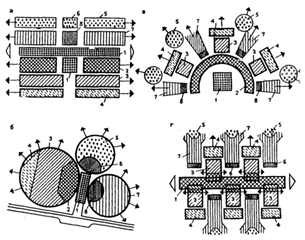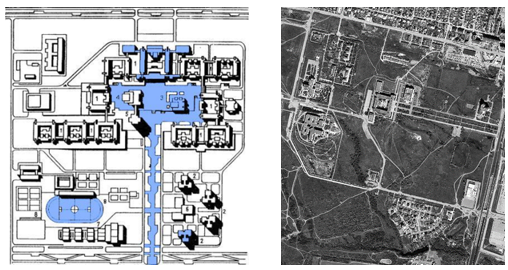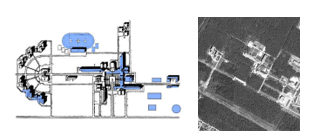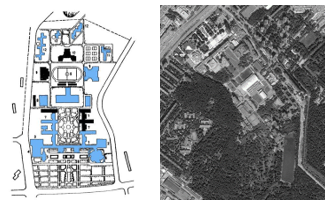Introduction
The campuses of modern institutions of higher education are not only teaching facilities, but also places for accommodation, research, everyday activities, recreation, and much more. The topic is of particular relevance at present, as large-scale construction of university campuses is planned in Russia. The need for this development is emphasized in the national project "Science and Universities".
The period after the Second World War and the years of intensive scientific and technological progress and development of the national economy that followed, posed a serious challenge to the Soviet economy to increase the number of university graduates in a planned manner. The then Minister of Higher and Secondary Specialized Education Yelutin (1980) noted that between 1975 and 1980, it was necessary to train 3.4 million highly qualified specialists, not only with scientific and practical knowledge, but also culturally, politically, and physically educated. It was in the 1970s and 1980s that the higher education system of the USSR blossomed - the number of workers with higher education almost doubled. To meet the targets, 93 universities were opened (built or reorganized).
Methodology
Research into the trends of development of higher education institutions founded in the USSR period was conducted through the study of the main legal documents of the considered period regulating the design of campuses (in the terminology of the 1970s and 1980s - complexes) of educational institutions, as well as general plans and the urban planning context of the location of individual universities. Common architectural and planning solutions and patterns and special solutions were identified. The advantages and drawbacks of the Soviet approach to the urban planning of higher education institutions were analyzed.
Research on the implementation of general plans of universities was supplemented by a study of the current state of the campuses chosen for consideration using a variety of sources. To compare the planned development and realized potential, we chose such parameters as the planned and actual number of students, the profile of the educational organization, the development of urban infrastructure near the university, the number of buildings erected according to the master plan, and the presence of buildings and functional facilities not provided by the master plan.
To illustrate the development of universities the paper provides schemes with a color indication of the implemented objects of the master plan.
Development
Given the specifics of the various educational programs, the development of scientific research, the large territories occupied by the complexes of higher education institutions (Borodina et al., 2023), and the urban planning context, the construction of universities according to standard designs seemed inexpedient. However, Soviet architects and urban planners adhered to certain solutions and principles:
zoning of the territories of universities and institutes, the allocation of educational, research and production, public, community, cultural, residential, sports and recreational, and other zones;
reation of modern expressive architectural ensembles;
combining small institutions of higher education into complexes, creating university towns;
location of higher education institutions with consideration of the planning structure of the city (polytechnic institutes were located near industrial zones, agricultural institutes were closer to the periphery of the city, and medical institutes cooperated with city clinics and hospitals);
connection of the complex buildings by off-street passages (as a rule, at the second-floor level) and the use of underground space.

Fig 1 - Principle scheme of the location of universities in the city. Architects G. Tsytovich and G. Kretova (1 - university; institutes: 2 - agricultural; 3 - technical; 4 - economic; 5 - medical; 6 - polytechnic; 7 - physical education; 8 - arts and culture; 9 - large university complex; 10 - city center; 11 - residential area; 12 - industrial area; 13 - park area; 14 - area of city hospitals and clinics; 15 - academic town; 16 - state farmland).
Prospects for the development (Figure 1) of higher education institutions were given consideration, and areas for the construction of new educational buildings and infrastructure were allocated. The main schemes of spatial development are shown in Figure 2 - linear (a, d) and centric (b, c). It was assumed that the individual zones of the academic building could develop both separately and with interpenetration, which was typical for the largest universities. The university social center (1) was usually central in the layout. It was adjacent to the academic-administrative zone (2) and scientific-laboratory buildings (3, 4), while residential, sports, and communal zones were located on the periphery (5-8).

Fig. 2 - Schemes of the spatial development of higher education institutions. Architect G. Tsytovich.
The central advantage of this approach was the creation of self-sufficient educational complexes capable of providing students with both places of residence immediately adjacent to the educational institution and sufficient scientific or industrial practice during their studies. Consideration was given to providing for the needs of students in physical activity, leisure, and cultural development. In the practice of designing residential and educational buildings, a variety of planning schemes can be noted (Popov, 2019), the architecture of which is discussed in more detail in other works.
The disadvantage is that in the 1980s the higher education system outstripped the needs of the economy for highly qualified specialists. In the considered period the number of universities and students was constantly growing (Volkov, 1999; Yeliutin, 1980) and by the 1990s the number of universities approached 900 and the number of students - 5 million. Some researchers criticize higher education of the 1980s and 1990s for excessive emphasis on quantitative gross indicators (Lisitskii et al., 2017).
Analysis of the general plans of universities of the period and their current physical incarnation shows that the complexes of many universities have not yet been implemented to the designed extent. The Volgograd State University can be taken as an example. The master plan called for the construction of a complex for 6,000 students. Today, the university has about 12,000 students, and less than half of the facilities proposed by the original project have been implemented. The core of the academic buildings and one of the four student dormitories were erected, and in place of the proposed library, the building of admission committee was built. A soccer field and boulevard have been landscaped. The territory of the university not taken up by buildings allows for the gradual construction of new buildings (Figure 3).

Fig. 3 - The general plan of the Volgograd State University and aerial photography. Blue shows the implemented part of the plan (1 - academic buildings; 2 - student dormitory buildings; 3 - library; 4 - assembly hall; 5 - rectorate; 6 - community and shopping center with a canteen; 7 - sports building; 8 - sports fields).
Another example is the Obninsk Institute for Nuclear Power Engineering, which now teaches about 3,000 students, slightly less than the planned number. In line with the master plan, almost all academic buildings, half of the dormitories, utility facilities, a fitness center, and athletic fields were built. The outpatient clinic and community center, the construction of which could have promoted the development of the campus, were not erected given the location of the institute on the outskirts of the city. An archive has been built, and instead of several science buildings, a technopark building was added (Figure 4).

Fig. 4 - General plan and aerial photography of the Obninsk Institute for Nuclear Power Engineering. Blue shows the implemented part of the plan (1 - administrative building; 2 - educational buildings; 3 - utility structures; 4 - science buildings; 5 - community and social centers; 6 - outpatient clinic with a preventorium; 7 - sports buildings; 8 - dormitories with primary service units).
Among the reasons for the incomplete implementation of the projects, we can point out the gradual decrease in funding for higher education since the 1980s and its dramatic drop since the 1990s, as well as uneven development in the later periods. Certain universities, such as regional and federal research centers and the largest sectoral universities, having somewhat greater access to resources for development, have implemented the original idea of the architects to the greatest extent (Yu et al., 2022).
An example of this is the Moscow State University of Civil Engineering. The campus general plan is implemented almost in full: the major part of the planned educational buildings and dormitories, as well as sports complexes, were erected. A part of the secondary objects (sports arena, swimming pool) was completed after 2010, which is evidence of the ongoing development of the university in accordance with the modern demands of its students and the residents of the surrounding areas of the city (Figure 5).

Fig. 5 - General plan and aerial photography of the Moscow State University of Civil Engineering. Blue shows the implemented part of the plan (1 - junior year building; 2 - canteen; 3 - library; 4 - assembly hall; 5 - rectorate; 6 - classroom block; 7 - departments; 8 - service buildings; 9 - sports palace, swimming pool, arena, stadium; 10 - community center; 11 - preventorium; 12 - dormitories).
We can note a somewhat insufficient focus of many projects of the period on the formation of public spaces, while to us and many other researchers (Shestopalova, 1992; Popov, 2018; Finogenov & Popov, 2019; Gelfond & Lapshin, 2020; Popov & Syrova, 2021; Gelfond, 2022), such spaces appear to be an important part of university campuses.
Conclusions
Bringing the analysis to a close, we can infer that the 1970s-1980s were marked by the development of a large number of general plans that provided for the construction and future operation of many higher education institutions of different sizes and orientations. Of note is the comprehensive approach of architects of the time to the development of general plans for universities. University complexes are still successfully functioning today in accordance with the principles of planning, zoning, and spatial coherence established in the Soviet era. The analysis of the current state of higher education institutions demonstrates that at present the planning potential of higher education institutions of this period is still not fully realized for several reasons. In the further development of these institutions, it is possible to rely on the original concept, making adjustments to fit the current trends and new challenges.
The general plans of universities developed in the Soviet times are distinguished by a well-thought-out planning structure that addresses most of the needs of the average student. Due to the general principles of zoning with the possibility of linear or centric development of each zone, such layouts are oriented towards dynamic development in space over time with the possibility of updating the functional content of individual zones.
In further research, it is expedient to explore the impact of the latest trends in higher education on the requirements for architectural and planning organization, to analyze the extent to which the original layout of higher education campuses can transform to meet new demands and to develop recommendations for improving academic, public, residential, and other areas of university campuses.














